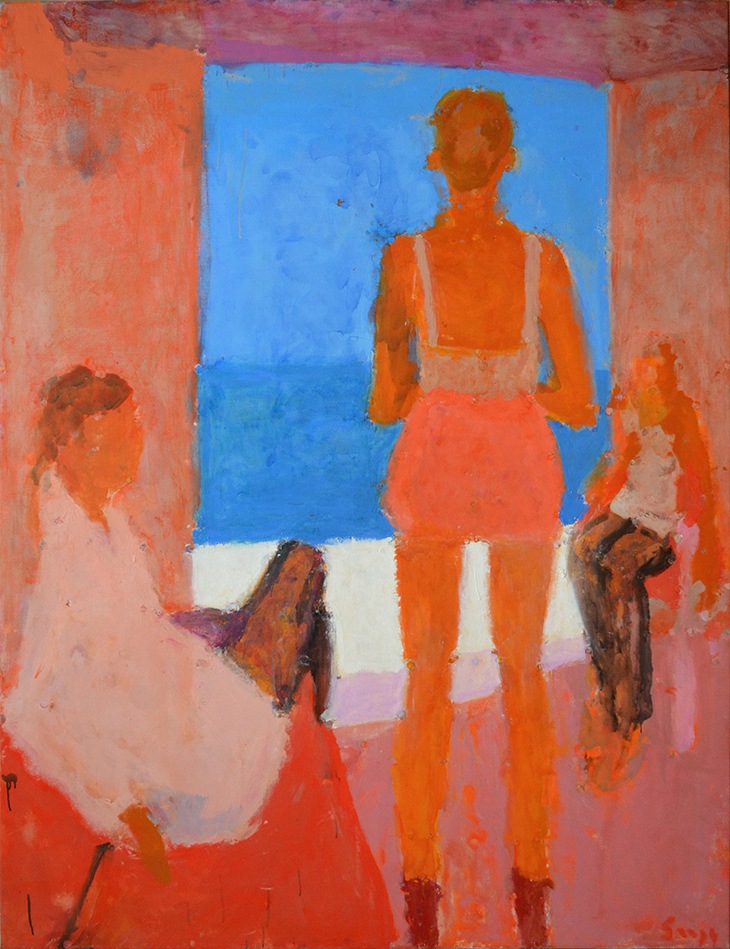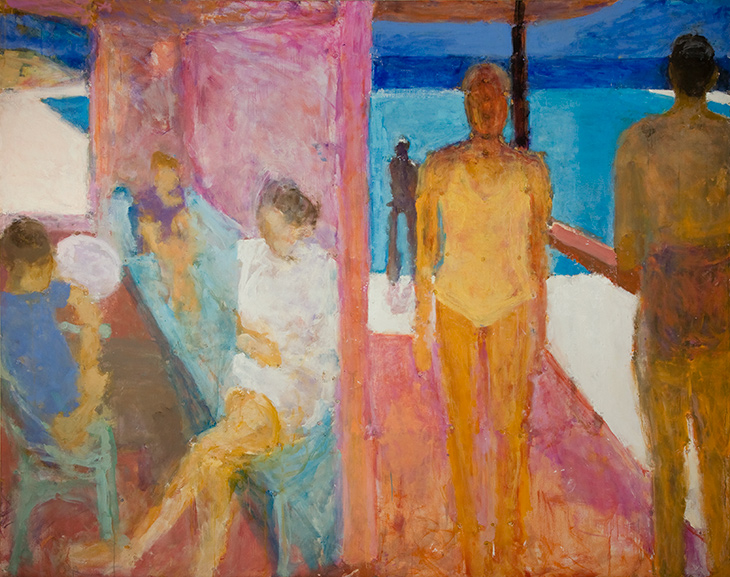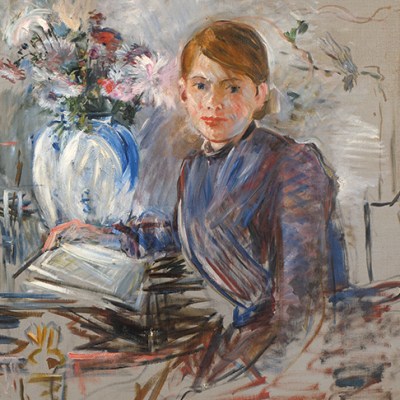In a room with open windows, perched above the sea, three figures gather with the languor of late summer. A girl in a bikini kneels on an orange divan looking out, her elbows on the sill; a woman ties back her hair. The sun slants through the window, catching on ankles and casting strips of shadow on the dusky floor. The painting, Three Bathers (2012) by the British painter Sargy Mann (1937–2015), conjures the sensation of the day’s residual heat, the hour in the afternoon when bodies rotate into shrinking patches of sun.
In Mann’s large figurative works, the subject of an exhibition curated by Chantal Joffe at the Royal Drawing School, the room is always the same. Neither fully open nor fully closed, it invites the outside world in while maintaining the intimacy of a domestic interior. The window is a blue box opening on to sea and sky, offering an occasional glimpse of a scorched landscape, while inside, the space is peopled with figures slouching on a lilacky green couch, the rose-pink walls falling into corners of shadow. It is a room both real and imagined: the geometric parallel of Mann’s own sitting room overlaid with visions of places constructed from memory.
Bonnard Drawing on the Pink Path (2009), Sargy Mann

One morning in 2005, two days after he returned from a trip to Cadaqués, a fishing village in northern Spain, Mann woke to total blindness. He had suffered for years with his eyes – with cataracts and with an oedema of the cornea, causing watery vision – and, eventually, his sight faded to black. He began to inhabit the world as a blind man: navigating by touch, measuring, matching architectural contours with memory. As he climbed the stairs in his Suffolk home – which, bordered by a wooden banister, lead into a small sitting room – he became conscious of how the space resembled another: Pierre Bonnard’s terrace at Ma Roulotte. In that moment, Mann perceived how he could paint: using the dimensions of a real space in his house, he could recreate the scenes and colours of others, of Cadaqués (as in Black Windows, 2006) and of other remembered landscapes.
Three Figures by the Sea (2014), Sargy Mann

In these scenes, Mann began to place the human figure: first, his wife Frances, sitting in a chair as he knelt before her, translating her form and depth on to canvas using a measuring stick; then, as he grew bolder and more excited, his children, arranged loosely in the small sitting room. He used lumps of Blu Tack to mark out his compositions on canvas, their wavering lines creating a tactual sketch before the colours were arranged on top. This system of mark-making – of measuring and remeasuring, carefully calculating proportions – owes much to Euan Uglow, his teacher at the Slade School of Fine Art in the late 1960s. Like Uglow, Mann left his marks on the canvas; in Three Figures by the Sea (2014), the tacky dots determine the vertical positioning of the girl in the centre, pock-marking the surface of the painting. Mann’s new haptic process provided him with a system for painting. In these late works, the pleasing repetitiousness of a space visited and revisited exposes the tension between rule-making and freedom, the established dimensions of the paintings waiting to be filled with infinite possible imagined narratives.
Up close, the paintings feel enlarged and the figures weighty, pushing at the edges of the frame. Mann learned his wide angles from Bonnard, who was radical in his attempts to paint according to the full field of human vision. Like Bonnard, Mann resisted foreshortening (the condensing of the subject within the frame), instead arranging his often life-size bodies three or four feet away, within touching distance, so that they appear vital and close. In his Infinity Pool series (2009–13), his compositions span nearly 180 degrees; falling into two halves, they give the viewer a continuous scene, from the seated figures, sheltering from the heat, to those outside, caught in movement. Mann captures the scene as it appears to the eye; the high contrast of late afternoon sun, the lethargy of bodies, the stickiness of passing time.
Infinity Pool II (2010), Sargy Mann

Mann recorded in his sketchbook that he visited the 1966 exhibition of Bonnard’s work at the Royal Academy 24 times. He visited his houses, Ma Roulotte and La Bosque, measuring and photographing the rooms. It was the sustained effort of his career to understand Bonnard’s perspectives, his interpretation of space. In his own paintings, the architecture is there, matched by colour entirely his own. Arranging his palette the same way each day, Mann mixed from memory, laying out patches of coral pink, blood orange and blue, heightening skin tones, playing with shadows. His figures – caught in conversation, passing time – are both content and inattentive, and near enough to touch. We’re drawn in close, invited to share their space.
‘Sargy Mann: Late Paintings’ is at the Royal Drawing School, Shoreditch, until 10 March.



